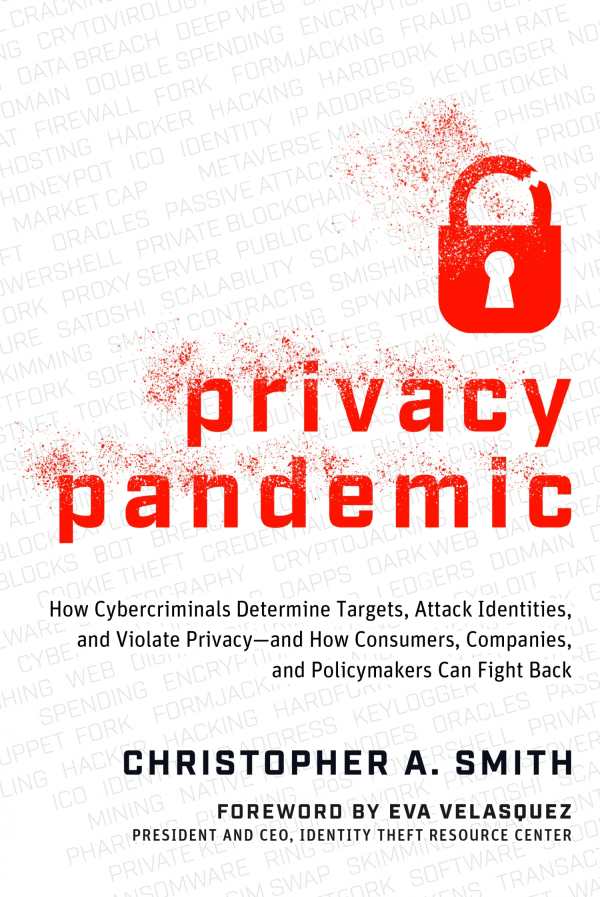Privacy Pandemic
How Cybercriminals Determine Targets, Attack Identities, and Violate Privacy—and How Consumers, Companies, and Policymakers Can Fight Back
- 2023 INDIES Winner
- Honorable Mention, Science & Technology (Adult Nonfiction)
The illuminating technology guide Privacy Pandemic issues proposals for protecting against dangers related to digital crime and unsecured personal data.
Startup founder and tech executive Christopher A. Smith’s Privacy Pandemic is a paranoia-inducing exploration of cybercrime and identity theft from someone who has experienced its brutal realities up close.
After giving an old iPhone to his then-girlfriend, Smith became the subject of virulent cyberattacks. He embarked on a years-spanning crusade to secure his digital identity and build a legal case against his attackers. Woven into an authoritative account of privacy and security in the modern world, Privacy Pandemic leverages Smith’s hard-won knowledge to provide best-practice advice for mitigating cyberattacks, protecting one’s personal information, and interacting with every aspect of the digital environment. Along the way, it makes provocative, research-based arguments for updating or abandoning old technology like social security numbers and terms-of-service agreements.
Highlighting the rapid increase of identity theft in the United States (documented cases increased from 650,000 in 2019 to 1.4 million in 2020), Smith writes, “The solution isn’t exclusively better technology. It’s correcting human behavior and giving us better tools.” Without overlooking the flawed data management practices and security systems employed by large organizations, Smith observes that the casual sacrifice of privacy for increased convenience—such as shopping and banking online via unsecured internet connections in public—is one of the major drivers behind cybercrime. To this end, Privacy Pandemic advocates for increased agency and security awareness on the part of everyday consumers. Practical steps like changing passwords, updating cellphone settings, and being wary of unsecured WiFi networks are imbued with the significance of real-world examples—as Smith writes, “There are two kinds of digital consumers: those who have been targets of identity theft and those who will be targets of identity theft.”
The conversational prose has a propulsive effect, striking a delicate balance between historical and digital analyses and the narrative thrust of a memoir. Smith’s experiences are covered with flavors of intrigue and espionage, helping to flesh out the book’s drier statistical information and expert commentary. Each step in his work to discover how criminals were capturing and using his information becomes the basis for a potent lesson in understanding cybersecurity and preempting attacks.
Digressive educational subsections on developments in the World Wide Web are included with each chapter, covering topics including the ins and outs of blockchains and detailed action plans following privacy breaches. Organized into four overarching subjects, the book also makes use of an ongoing analogy between cybersecurity risks and COVID-19. Still, in likening privacy invasions to the pandemic, the book dates its arguments somewhat:
As with COVID-19, we might never be able to eradicate the disease, but we can minimize its impact so it’s no longer a mortal threat but an inconvenience to be handled with vigilance and preparation.
Drawing on a harrowing personal story, the technology guide Privacy Pandemic argues that digital crime and unsecured personal data pose enormous dangers—and issues proposals for protecting against them.
Reviewed by
Willem Marx
Disclosure: This article is not an endorsement, but a review. The publisher of this book provided free copies of the book and paid a small fee to have their book reviewed by a professional reviewer. Foreword Reviews and Clarion Reviews make no guarantee that the publisher will receive a positive review. Foreword Magazine, Inc. is disclosing this in accordance with the Federal Trade Commission’s 16 CFR, Part 255.

